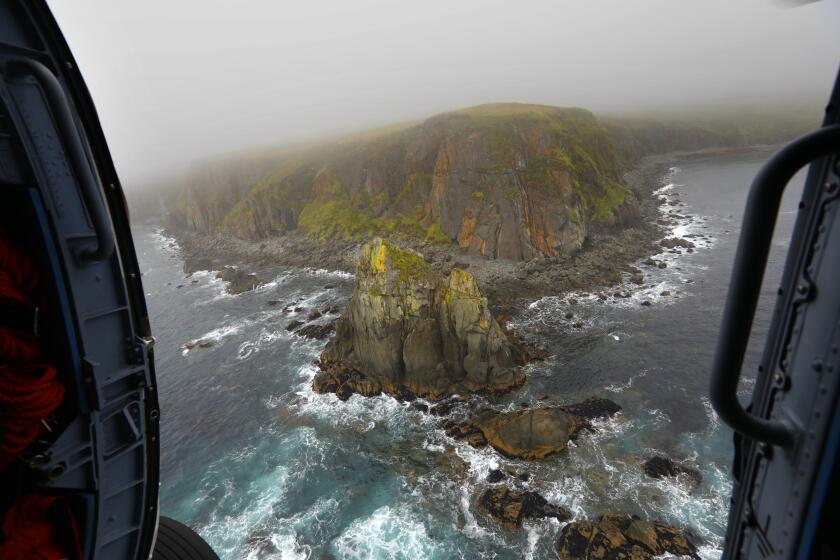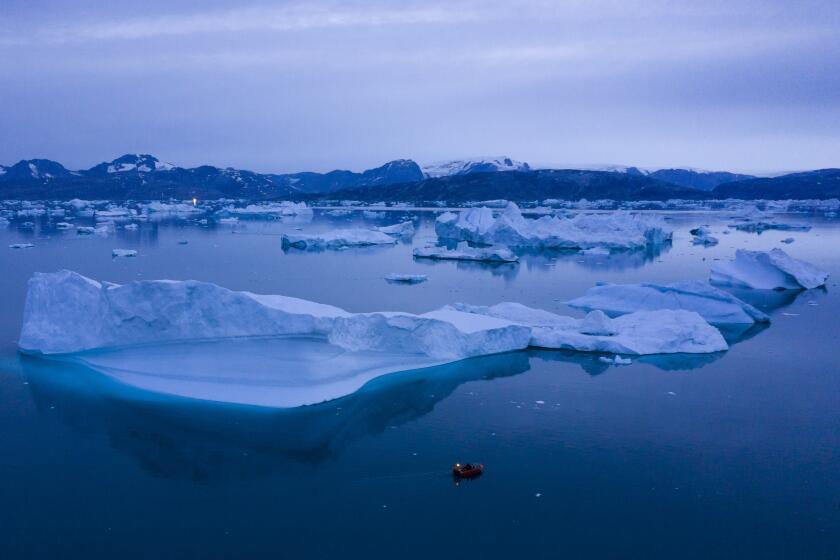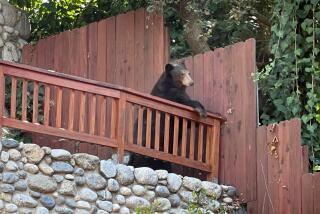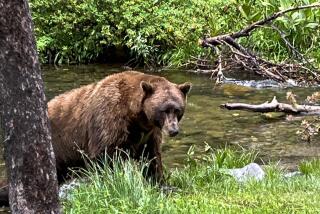Polar bear kills woman and 1-year-old, tries to breach a school in Alaska village

- Share via
ANCHORAGE — A polar bear chased several residents around a tiny, isolated Alaska Native whaling village, killing a mother and her 1-year-old son in an extremely rare attack before another community member shot and killed the bear, authorities said.
The fatal mauling, the first in more than 30 years in Alaska, happened Tuesday next to the front entrance of the school in Wales, an isolated Bering Strait coastal community on the westernmost tip of the North American mainland — about 50 miles from Russia — that is no stranger to coexisting with polar bears.
School officials rushed people into the building after the polar bear was spotted, Bering Strait School District chief administrator Susan Nedza told the Anchorage Daily News from her office in Unalakleet.
“The bear tried to enter with them,” Nedza said, but Principal Dawn Hendrickson “slammed the door” to keep it out.
“It’s terrifying. Not something you’re ever prepared for,” said Nedza, who didn’t return messages to the Associated Press on Wednesday.
School district officials pulled the shades in the school and locked down the building. They eventually got word out that they needed someone to “take care of the bear.”
Summer Myomick of St. Michael and her son, Clyde Ongtowasruk, were killed in the attack, Alaska state troopers said in a statement.
Her parents declined interviews with the Associated Press when reached Wednesday at their home.
“It’s very, very sad for St. Michael right now and Wales,” said Virginia Washington, the St. Michael city administrator. She said Myomick split time between the two communities.
“She was a very sweet lady. She was very responsible,” Washington said.
The heating of the planet is pushing Earth’s polar bear population to its limit, and according to a new study they could have fewer than 100 years left before extinction.
Like many far-flung Alaska villages, the predominantly Inupiaq community of roughly 150 people in Wales has organized patrols when the bears are expected in town, from roughly December to May, said Geoff York, the senior director of conservation at Polar Bear International. The last fatal polar bear encounter in Alaska was in 1990.
Poor weather and a lack of runway lights at the Wales gravel air strip prevented troopers and wildlife officials from making it to Wales on Tuesday after the polar bear attack. Attempts were being made again Wednesday.
Asked to describe the mood in Wales on Wednesday, Hendrickson, the school principal, called it “traumatic.” Classes were canceled, and counselors were being made available.
She said there have been no announcements for memorials for the two victims. “We are still in the beginning phase,” said Hendrickson, who spoke to the AP earlier in the day but didn’t detail the polar bear attempting to breach the school.
Scientists are seeing changes off Alaska that have never been documented before, as warming upsets a vast ecosystem and one of the world’s vital fisheries.
It’s unclear whether this attack was related to climate change, but it’s consistent with what is expected as the Arctic continues to warm at four times the rate of the rest of Earth, changing the ecosystem in ways that are still not fully understood, York said.
However, this particular bear is a member of a population that is doing fairly well, said Andrew Derocher, a professor of biological sciences at University of Alberta and an expert on polar bears.
Alaska scientists at the U.S. Geological Survey in 2019 found changes in sea ice habitat had coincided with evidence that polar bears’ use of land was increasing and that the chances of a polar bear encounter had increased.
Wales is just over 100 miles northwest of Nome. The community is accessible by plane and boats, including barges that deliver household goods. Winter trails provide access on snowmobiles to other communities and to subsistence hunting grounds. All-terrain vehicles are used for nonwinter hunting and fishing trips.
Polar bears are the largest bear species, according to the U.S. Fish and Wildlife Service. Males can weigh more than 1,700 pounds, but typically weigh 600 to 1,200 pounds and reach up to 10 feet in length. Females weigh 400 to 700 pounds. Polar bears generally feed on seals but also prey on walruses and beluga whales.
Climate change: Greenland is its warmest in more tan 1,000 years, data show. Scientists expect more temperature rise as the island’s glaciers melt faster.
Polar bears were listed as threatened under the Endangered Species Act in 2008. They are also covered by the Marine Mammal Protection Act. Both laws prohibit harming the animals without authorization, unless necessary for human safety.
Polar bears are at the top of the food chain and see humans as a food source, York said. Fatal polar bear encounters usually involve young bears, usually males, who are hungry all the time, or older bears who are injured or ill and having difficulty getting enough calories.
“Both of those bear types are more likely to take risks, like we saw here in Wales,” York said.
Unlike brown or black bears, polar bears do not hibernate in the winter. Only pregnant females enter snow dens, and that’s only for reproduction.
All the other polar bears are out, typically on sea ice where their prey is available year-round.
The Alaska Nannut Co-Management Council, which was created to represent “the collective Alaska Native voice in polar bear co-management,” on its website says polar bears near or entering villages represent ongoing safety concerns for communities within polar bear territory.
Joseph Jessup McDermott, executive director of the Alaska Nannut Co-Management Council, which represents tribes that have hunted polar bears for subsistence, said the bear patrol in Wales “is not currently active” because “it essentially lost what funding it had.” The organization has been working with the World Wildlife Fund and other partners to restore the patrol program, McDermott said.
Besides being part of the bear patrol program, York said Wales has taken other measures to keep polar bears out of the community.
The bear is from a population in the Chukchi Sea that is faring well amid climate change, Derocher said. That means the attack could be the result of a bear lured by attractants such as food or garbage.
Polar bears of the southern Beaufort Sea, east of the Chukchi Sea population, are in worse shape, Derocher said.
In this case, even though there is ice in the Chukchi and northern Bering seas, the quality of that ice is not known that well. More importantly, York said they don’t know what’s going on under the ice — or what the availability of seals and other prey is for polar bears.
More to Read
Sign up for Essential California
The most important California stories and recommendations in your inbox every morning.
You may occasionally receive promotional content from the Los Angeles Times.















